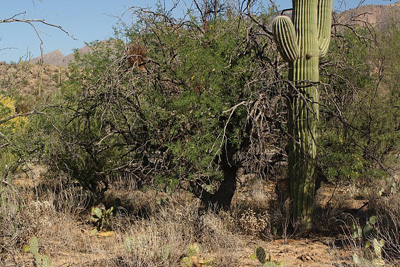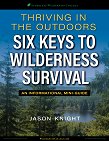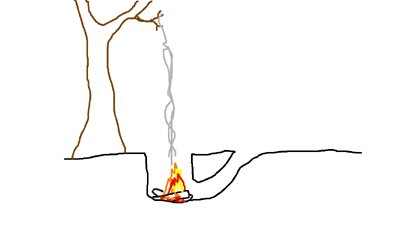Wilderness Evasion

Wilderness Evasion is simply: how to remain undetected in the wilderness. These skills are vital to the survival of many animals, like the two deer in the photo above. These are skill that many Native American tribes mastered in times of war. The famous Apache Chief, Geronimo “led a small band of 36 men, women, and children. They evaded thousands of Mexican and American troops for over a year, making him the most famous Native American of the time… His band was one of the last major forces of independent Native American warriors who refused to accept the United States occupation of the American West.”
What are the skills that enabled Geronimo to
evade the Mexican and American troops for so long? I can only imagine. But in this article you will find some
wilderness evasion techniques that will greatly improve your chances of remaining hidden in the
woods.
Evading Trackers
The best way to learn how to evade a tracker is to learn tracking. Practice following the tracks of a friend in snow or sand and pay attention to when you lose the trail. Evading a tracker is more about slowing down the tracker and creating distance than making the tracker permanently loose the trail. Here are some ways you can use wilderness evasion and slow down a tracker:
Changing shoe tread – trackers will key in on a certain shoe tread so if you have the ability to change shoes at different points along the trail it may help to confuse the tracker. Shoes with indistinct tread is also a plus.
90 degree turn with a hidden view - find a place along the side of the trail where the view is blocked by a tree or boulder, cut a sharp turn behind that obstacle.
Use Roads – Before you reach a road, start angling your tracks to indicate that you are travelling one way up the road, then, once you are on the road where your tracks are undetectable, reverse your direction and go back the other way. If you can cover several hundred yards on the road before hopping back into the woods you may buy yourself several hours.
Evading Dogs
Evading dogs is extremely challenging once they have your scent. Dogs track best in cool moist environments. In hot, dry, windy environments dogs tire quickly and lose the scent frequently. Here are some tricks that may help:
- Cross obstacles that are hard for the dogs to follow like fallen
logs or steep rock faces.
- Make several sharp direction changes. This serves to make the handler doubt the dog
which may cause him to call off the search.
- Move with the wind. Hunters are well aware that smells float downwind. If you have the option to move upwind or downwind, moving downwind (with the wind) will greatly improve your chances of evading scent dogs.
Be More Prepared For Your Next Outdoor Adventure!

Don't leave without knowing these six essential survival skills. Our free survival mini guide reveals the strategies of:
- Shelter & fire to prevent the number one cause of death
- Obtaining clean water to avoid life-threatening dehydration
- Common wild survival foods and other critical skills!

Invisible Camping
When learning wilderness evasion, remember that one of the easiest ways to be discovered while your camping is from your fire. At night the light from a fire can be seen from miles away and during the day the smoke from a fire may be just as conspicuous. Consider the type of landscape you are in.
If it is a dry, arid landscape then you should have your fire during the day. If your wood is dry and you remove the bark it is possible to have a fire that produces very little smoke. Also, in open, arid landscapes there is very little cover from trees to hide the firelight so having a fire at night would be difficult to conceal.
If you are in a forested landscape then having your fire at night is the best option. You can use the trees to hide the light of the fire and at night, smoke is not very visible.
In the image below you can see a technique for concealing your fire from view. It is important to dig an air hole from the side to allow the fire to burn well.

Invisible Shelters
If you need to build a semi-permanent shelter and you have the means to do it, a pit shelter is a great option and can be concealed so well that a person can walk over it without knowing its there.
The pit shelter is a very simple but effective form of wilderness evasion. What is not shown in the image below is a door plug. This may look like a “raft” of sticks lashed together that can be pulled down after you enter the shelter. This shelter requires a lot of digging and may not be practical without a shovel. To construct the shelter, dig a pit that is comfortable to lie down in, three feet deep. Leave a shelf, eight inches deep and eight inches wide surrounding the whole pit. Cover the pit with sturdy logs. It is important to choose solid logs so that if a person walks over the pit, they don’t feel the ground bounce. Cover the logs with leaves and soil. The final step is to re-vegetate the soil so that it looks like nothing happened there. In time, the plants will grow and the pit will be completely concealed. Don’t forget to fill the inside of the pit with leaves for insulation.

Travelling Invisibly
This is the final part of wilderness evasion and also the one that takes the longest to learn. It is a lifelong journey to truly master invisibility in the wilderness. It requires intense knowledge of place, local flora and fauna, an intuitive knowledge of bird and animal behavior and much physical training. It is wise to follow the behavior of the most elusive animals such as the mountain lion. They do most of their activity at night or around dawn and dusk. They move slowly, sitting and listening for long periods of time before they move. Each foot is lifted and placed with care so as to not break any sticks or make any more noise than necessary.
Use shadows and camouflage. With simple natural materials, one can camouflage themselves better than even the most expensive camo clothing from Cabela’s. Start with a dusting of ash to dull the skin, then apply a dappling of mud, clay and charcoal. Lastly sprinkle on forest duff, leaves and pine needles. Essentially turning your self into the forest floor. It is important to focus on breaking up your outline and the recognizable structure of your face and shoulders.
Play Games
Finally, practice your skills of wilderness evasion by playing games. Everybody loves hide and seek and capture the flag. Try playing these games at night in the forest with a group of friends in full mud camo. Maybe you won’t be able to do what Geronimo could but I guarantee you will be in for a good time and you will greatly improve your skills of wilderness evasion.
Good luck!
By the way, if you enjoyed this article then you'll love our survival mini guide. You'll discover six key strategies to staying alive in the outdoors plus often-overlooked survival tips. We're currently giving away free copies here.
Further Resources:
Recommended Books:
Wilderness Evasion by Michael Chesbro
Foundations for Awareness, Signcutting and Tracking by Robert Speiden
Related Courses:
Wilderness Survival Courses at Alderleaf
Wildlife Tracking Courses at Alderleaf

About the Author: Connor O'Malley is an experienced wilderness skills educator. He taught at Alderleaf for several years. Learn more about Connor O'Malley.
Return from Wilderness Evasion back to Wilderness Survival Articles
Is The Essential Wilderness Survival Skills Course Right for You? Take the "Online Survival Training Readiness" Quiz
See for yourself if this eye-opening course is a good fit for you. It takes just a few minutes! Get your Survival Training Readiness Score Now!

Grow Your Outdoor Skills! Get monthly updates on new wilderness skills, upcoming courses, and special opportunities. Join the free Alderleaf eNews and as a welcome gift you'll get a copy of our Mini Survival Guide.

 The Six Keys to Survival: Get a free copy of our survival mini-guide and monthly tips!
The Six Keys to Survival: Get a free copy of our survival mini-guide and monthly tips!
Learn more